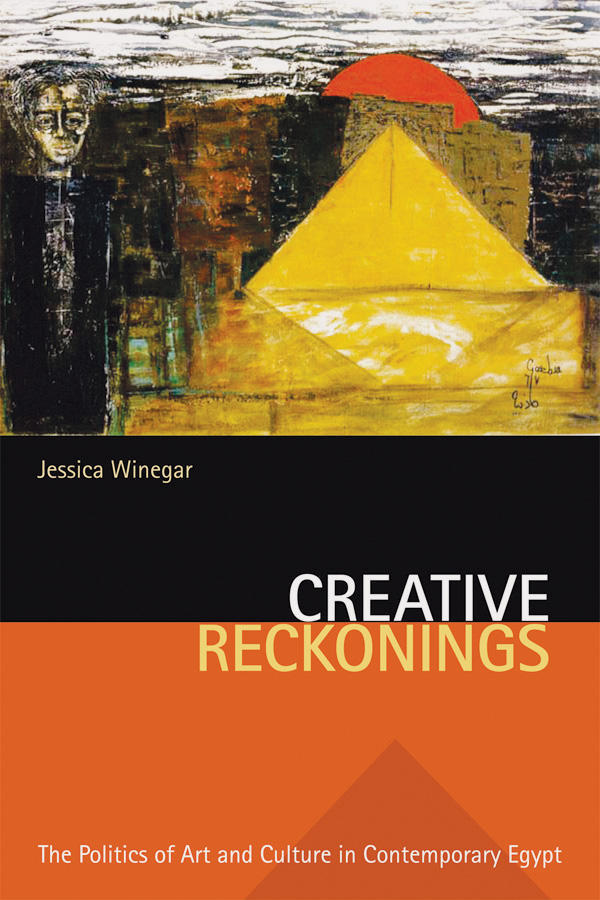
Creative Reckonings: The Politics of Art and Culture in Egypt
By Jessica Winegar
Stanford University Press, 2006
The assumption of an anthropological posture in art contexts, if done right, can have the effect of the strategic name-drop, intended to inspire anxiety in others and signal one’s own familiarity and access. The earnest and diligent approach of the true anthropologist can seem dull by comparison.
Better perhaps to be suggestive and opaque. Creative Reckonings, Jessica Winegar’s recent book on “what it means to practice modern art from a location and history traditionally positioned at the periphery of Euro-American modernisms,” was researched over a period of eight years (1996–2004), during which time she intermittently visited and lived in Cairo. Winegar is careful to point out that hers is not a formal analysis of artwork or discussion of the merits of individual artists; hers is a piece of anthropological scholarship, and this approach, she asserts, is in fact appropriate to the concerns and discourse-based dynamics of her subjects: Egypt’s “arts interlocutors.”
The “nation” functions critically within Winegar’s analysis as a framework for “perceiving and evaluating artworks, for articulating one’s understandings of history and social change, for making sense of one’s experiences, and for making, staking, and organizing political claims.” She understands the nation — rightly, I think — as a lens through which artistic and intellectual practice are defined and pursued, enforcing always the validating concept of “the modern.” Egypt’s uneven neoliberal reforms of the 1990s opened the country up to foreign investment and financial restructuring, while the development of organized arts activity outside the sphere of state hegemony was treated as a threat, not only to a post-revolutionary, government-sanctioned cultural production, but also to its attendant agendas of social policy and national image-management. As Winegar tells us, the establishment of commercial and independent galleries and a novel outside interest in young Egyptian artists reinvigorated old tensions whose dividing lines and loyalties — in a context variously iterated as postcolonial, quasi-postsocialist, and quasi-neoliberal — are far from straightforward. Her introductory discussion argues compellingly for a highly contested field in a state of flux, an arena of visual arts production fundamentally informed by an awareness of art practice as a mode of self-representation situating the artist in relation to long contested tropes of culture and nationality.

Though the nation is a recurrent theme throughout, Winegar also insists on the importance of generational interrelation and class-related dynamics. A chapter entitled “Freedom of Talk: Cultural Policy and the Transforming State” looks at the role of state institutions in defining the “position-takings available to artists” and government arts policy from Nasser to Mubarak. Other chapters deal with arts education in the public sector, practices and ideologies of collecting, the relationship of artists to the public, and discursively defined ideas of artistic authenticity. She ends with a discussion of the development of the private sector and the increasing interface between “local” and “international” arts practices. Perhaps the most important aspect of this work is its act of articulation; the complexity underlying the dynamics of art practice, exhibition, and selling in Egypt is rarely spelled out, as though to do so were somehow bad form.
At times, though, Winegar’s brand of anthropology seems to be just that — a brand, a mode. As soon as her “arts interlocutors” and “subjects” step outside the asserted scholarly frame of research, the impulse to document and explain feels somewhat perverse. Awkwardly personal and confessional passages meant to acknowledge her involvement within the sphere she is documenting are interspersed with overly schematic mappings of the discourses people draw on to represent and situate themselves socially, politically, and culturally. Individuals, conversations, and casual moments are made to represent aspects of her analysis. She visits a young collector whom she describes as “exemplify[ing] how neoliberal capitalist globalization has actually enhanced the national attachments of some of its biggest Egyptian beneficiaries — especially in the realm of the collection and display of culture.” Yet the passage opens with a disclosure that serves only to signal Winegar’s superficial investment in the situation and rather gauche and unimaginative “cultural” frame of reference: “As an anthropologist from the United States, I always have to wonder what is going on when I enter a fieldwork situation and suddenly become very comfortable. Cultural differences seem to fall by the wayside, and you feel as if you are just hanging out with ‘one of your own.’”
Explaining the intricacies of artistic practice and discourse in Egypt is certainly worthwhile. Ultimately, however, Winegar’s approach seems to offer little while claiming much. Her studied analysis lacks a sense of poetics and fails to capture how and why self-conception and representation are necessary and deeply compelling in these contexts. One is left with good intentions, a certain amount of valuable information, and an introduction to a complex and highly loaded situation. But one also has the sense of having been cheated out of a more compelling reality.